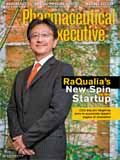Was 2011 the End of the Beginning?
The gap in perception is one of industry's biggest problems because it adds ballast to the idea that medicines are just a simple procurement item, writes William Looney.
2011 was an eventful year for pharma. The "muddle through" mindset has been replaced by active speculation about the long-term viability of the commercial business model, including the productivity of in-house R&D; impact of the patent cliff on margins; changing attitudes of regulators toward risk versus benefit; a new sobriety about the potential of emerging country markets; and the difficulty of brand messaging in an increasingly "non-promotional" world. An added spanner to the works is the mature country debt crisis and the dawning realization that the social benefit programs on which the industry increasingly depends for access to the patient will face significant constraints—putting still more pressure on the industry's frayed value proposition to payers.

William Looney
All these challenges are global and reflect a much larger degree of skepticism—in all markets—about how well the industry makes the case for that elusive "innovation premium." Is it well understood that innovation is not the science of invention, but a business process linked to finding practical uses for a new technology among a defined customer base that must be allowed to grow over time, especially because the impact on that all-important standard of care is usually incremental as well? Not really.
The gap in perception is one of the industry's biggest problems because it adds ballast to the idea that medicines are just a simple procurement item, like a surgical suture, to be purchased at rock-bottom prices in bulk tender contracts for placement on "essentials" formularies in which all patients are treated the same. This commoditization of the industry's offerings is the latent threat from the fiscal collapse of health systems in Europe. But it may also serve as a precedent for reimbursement policy in key emerging markets. What were once some of the most promising countries for margin growth—like Turkey—are already moving in that direction.
Our three main feature stories this month reveal how the industry is seeking alternatives to this adverse scenario. The approaches involve renewing the credentials for good science to underscore the pivotal role of medicines in healthcare markets; to build new organizational frameworks and the accompanying business culture changes that can speed new therapies to the patient; and to focus on services that go beyond the pill to ensure patients gain the positive outcomes associated with the treatment.
In the first instance, Pharm Exec's annual survey of the drug pipeline demonstrates that the disease pathways revealed by molecular biology is finally bearing fruit, in the form of treatments for unmet medical needs across a truly diverse range of therapeutics. Does it imply the productivity drought in R&D is over? Not by any means, but the trend shows that industry is no longer bound by the argument that since all the "low-hanging fruit" has been plucked, there can be little progress in expanding the range of therapies. In fact, our analysis confirms that pharma is still well positioned as the industry of the future. The big uncertainty lies in its antithesis, best expressed as whether science will be allowed the predictability required to prevail under the long lead times from proof of concept to clinical practice.
Next, our cover feature on the legacy Pfizer Japan startup venture, RaQualia, illustrates how seriously industry takes the issue of finding new organizational models to unleash the entrepreneurial instincts that lash innovation tightly around commercial relevance. Even in markets as highly regimented as Japan, that process translates easily into two words: customer value. CEO Atsushi Nagahisa's flat, integrative development decision model is most interesting for the challenge it poses to standard practice in Japan, where creativity must find its expression through chance exporting of the best science to other countries, because the domestic regulatory environment is so predictably constricting. In Japan, a new compound's highest price will always be its launch price, with a price drop following at regular intervals right through the end of the product life cycle
Pharm Exec's third feature illustrates the desirability of finding new partners to approach old topics, in a new way. Our Roundtable on medicines adherence took place on Oct. 12 with the active co-sponsorship of the National Consumers League, whose new campaign, "Script Your Future," promises to reinvigorate national efforts to get patients to take their medicines as prescribed. As our Q&A reveals, any attempt to engage additional stakeholders can create the synergies that build new platforms for change. We on the media side are proud to be associated with that effort.
